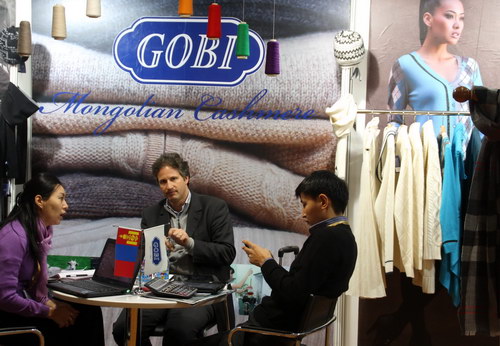Economy
Cashing in on cashmere
By Allison Jackson (China Daily)
Updated: 2011-05-05 09:51
 |
Large Medium Small |
 |
|
Business talks at the 2010 International Trade Fair for Cashmere in Beijing. China's cashmere clothing and accessories are finding a growing market at home. [Photo/China Daily] |
ORDOS, Inner Mongolia - Factory worker Wu Suqing hunches over a machine knitting a green cashmere sweater bound for a department store in China where demand for the luxury wool is growing even as Western sales shrink.
Surrounded by towering piles of brightly colored pullovers, Wu and dozens of workers at a factory in North China churn out more than 100,000 sweaters a year that retail in Beijing and Shanghai for hundreds of dollars each.
"At the beginning, I was tired, but now I'm used to it," Wu told AFP above the clamor of knitting machines in a dingy building in Ordos in North China's Inner Mongolia autonomous region.
China is the world's largest producer of cashmere, churning out 75 to 80 percent of the global supply - worth an estimated 5 to 6 billion yuan ($770 million to $920 million) each year.
|
||||
But the country's growing taste for luxury products is changing that.
High-altitude North and West China are ideal for producing the cloudlike wool. Their cold, dry winters cause the long-haired goats scattered across the region to grow rich coats to keep warm.
The soft fiber is spun into yarn and then knitted into sweaters, scarves and shawls, to be sold by luxury brands such as Hermes Group and Eric Bompard SA in Paris, New York and Sydney.
More than half of the country's cashmere clothing and accessories are still exported, but it is now finding a growing market in increasingly affluent Chinese cities.
"It is easy for a Chinese person to buy a cashmere sweater now. People are much richer than before," Zhang Quanxiang, vice-director of the China Livestock Marketing Association's cashmere department, told AFP.
The number of Chinese-made cashmere sweaters exported in 2010 fell to 12 million, down 33 percent from 2007, as the global financial crisis hit buyers in the United States and Europe, said Zhang, a former vice-president of China's largest cashmere producer, Ordos Group.
But he added that the growing Chinese market has helped to offset the decline.
Raw cashmere prices have nearly doubled in recent years because of a combination of factors: Chinese demand, fewer goats following recent bitterly cold winters, and a ban on grazing the sharp-hooved animals on open land in Inner Mongolia to prevent soil erosion.
The rising prices have been life-changing for herders such as Meng Lounu, 77, whose family lives in a village on the edge of the vast Gobi Desert where they raise hundreds of goats in large earthen-floor pens.
The family earns 1 million yuan a year selling cashmere to factories in Ordos.
| 分享按钮 |



